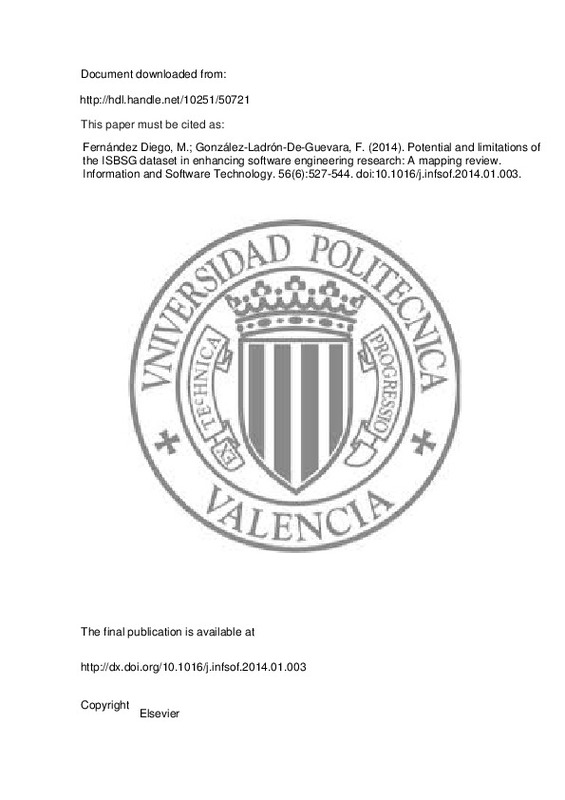JavaScript is disabled for your browser. Some features of this site may not work without it.
Buscar en RiuNet
Listar
Mi cuenta
Estadísticas
Ayuda RiuNet
Admin. UPV
Potential and limitations of the ISBSG dataset in enhancing software engineering research: A mapping review
Mostrar el registro sencillo del ítem
Ficheros en el ítem
| dc.contributor.author | Fernández Diego, Marta
|
es_ES |
| dc.contributor.author | González-Ladrón-de-Guevara, Fernando
|
es_ES |
| dc.date.accessioned | 2015-05-25T11:04:08Z | |
| dc.date.available | 2015-05-25T11:04:08Z | |
| dc.date.issued | 2014-06 | |
| dc.identifier.issn | 0950-5849 | |
| dc.identifier.uri | http://hdl.handle.net/10251/50721 | |
| dc.description.abstract | Context The International Software Benchmarking Standards Group (ISBSG) maintains a software development repository with over 6000 software projects. This dataset makes it possible to estimate a project s size, effort, duration, and cost. Objective The aim of this study was to determine how and to what extent, ISBSG has been used by researchers from 2000, when the first papers were published, until June of 2012. Method A systematic mapping review was used as the research method, which was applied to over 129 papers obtained after the filtering process. Results The papers were published in 19 journals and 40 conferences. Thirty-five percent of the papers published between years 2000 and 2011 have received at least one citation in journals and only five papers have received six or more citations. Effort variable is the focus of 70.5% of the papers, 22.5% center their research in a variable different from effort and 7% do not consider any target variable. Additionally, in as many as 70.5% of papers, effort estimation is the research topic, followed by dataset properties (36.4%). The more frequent methods are Regression (61.2%), Machine Learning (35.7%), and Estimation by Analogy (22.5%). ISBSG is used as the only support in 55% of the papers while the remaining papers use complementary datasets. The ISBSG release 10 is used most frequently with 32 references. Finally, some benefits and drawbacks of the usage of ISBSG have been highlighted. Conclusion This work presents a snapshot of the existing usage of ISBSG in software development research. ISBSG offers a wealth of information regarding practices from a wide range of organizations, applications, and development types, which constitutes its main potential. However, a data preparation process is required before any analysis. Lastly, the potential of ISBSG to develop new research is also outlined. | es_ES |
| dc.language | Inglés | es_ES |
| dc.publisher | Elsevier | es_ES |
| dc.relation.ispartof | Information and Software Technology | es_ES |
| dc.rights | Reserva de todos los derechos | es_ES |
| dc.subject | Systematic mapping study | es_ES |
| dc.subject | Research methods | es_ES |
| dc.subject | Software engineering | es_ES |
| dc.subject | ISBSG | es_ES |
| dc.subject | Software effort estimation | es_ES |
| dc.subject | Software cost prediction | es_ES |
| dc.subject.classification | ORGANIZACION DE EMPRESAS | es_ES |
| dc.title | Potential and limitations of the ISBSG dataset in enhancing software engineering research: A mapping review | es_ES |
| dc.type | Artículo | es_ES |
| dc.identifier.doi | 10.1016/j.infsof.2014.01.003 | |
| dc.rights.accessRights | Abierto | es_ES |
| dc.contributor.affiliation | Universitat Politècnica de València. Departamento de Organización de Empresas - Departament d'Organització d'Empreses | es_ES |
| dc.description.bibliographicCitation | Fernández Diego, M.; González-Ladrón-De-Guevara, F. (2014). Potential and limitations of the ISBSG dataset in enhancing software engineering research: A mapping review. Information and Software Technology. 56(6):527-544. doi:10.1016/j.infsof.2014.01.003 | es_ES |
| dc.description.accrualMethod | S | es_ES |
| dc.relation.publisherversion | http://dx.doi.org/10.1016/j.infsof.2014.01.003 | es_ES |
| dc.description.upvformatpinicio | 527 | es_ES |
| dc.description.upvformatpfin | 544 | es_ES |
| dc.type.version | info:eu-repo/semantics/publishedVersion | es_ES |
| dc.description.volume | 56 | es_ES |
| dc.description.issue | 6 | es_ES |
| dc.relation.senia | 261424 |







![[Cerrado]](/themes/UPV/images/candado.png)

